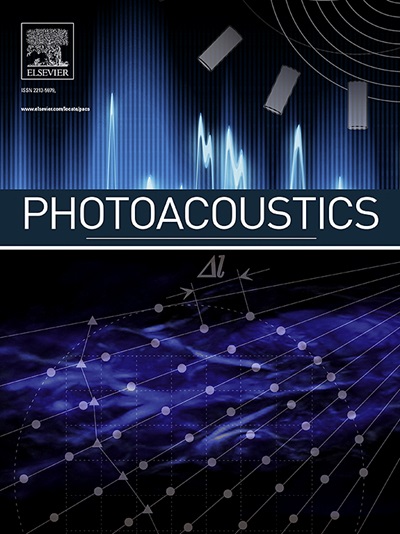Dual-gas quartz-enhanced photoacoustic spectroscopy sensor exploiting two fiber-combined interband cascade lasers
IF 6.8
1区 医学
Q1 ENGINEERING, BIOMEDICAL
引用次数: 0
Abstract
In this work, a novel indium fluoride glass 2-input-1-output fiber combiner was designed and fabricated to combine two Interband Cascade Laser (ICL) sources emitting in the mid-infrared wavelength range. To test the combiner performance, a dual-gas quartz-enhanced photoacoustic spectroscopy sensor was demonstrated for the detection of carbon dioxide (CO2) and nitric oxide (NO), employing two fiber-coupled ICLs having central emission wavelengths of 4,234 nm and 5,263 nm, respectively. The laser beams were coupled via the fiber combiner and then focused into a commercial acoustic detection module equipped with an input fiber-port, thus resulting in a plug-and-play sensing system. Tens of ppm-level detection limits at 3σ are achieved for both pollutants with a lock-in integration time (τ) of 0.1 s. Finally, an Allan-Werle analysis demonstrated the stability of the sensor, allowing the achievement of detection limit of 13 ppm and 4 ppm at τ = 10 s for CO2 and NO, respectively.
利用双光纤组合带间级联激光器的双气体石英增强光声光谱传感器。
本文设计并制作了一种新型的氟化铟玻璃2-输入-1-输出光纤组合器,用于组合发射中红外波段的两个带间级联激光器(ICL)源。为了测试该组合器的性能,采用两个中心发射波长分别为4,234 nm和5,263 nm的光纤耦合icl,演示了用于检测二氧化碳(CO2)和一氧化氮(NO)的双气体石英增强光声光谱传感器。激光束通过光纤组合器耦合,然后聚焦到配备有输入光纤端口的商用声学检测模块,从而形成即插即用的传感系统。对于锁定积分时间(τ)为0.1 s的两种污染物,在3σ处实现了数十ppm级的检测限。最后,Allan-Werle分析证明了该传感器的稳定性,在τ = 10 s时,CO2和NO的检测限分别为13 ppm和4 ppm。
本文章由计算机程序翻译,如有差异,请以英文原文为准。
求助全文
约1分钟内获得全文
求助全文
来源期刊

Photoacoustics
Physics and Astronomy-Atomic and Molecular Physics, and Optics
CiteScore
11.40
自引率
16.50%
发文量
96
审稿时长
53 days
期刊介绍:
The open access Photoacoustics journal (PACS) aims to publish original research and review contributions in the field of photoacoustics-optoacoustics-thermoacoustics. This field utilizes acoustical and ultrasonic phenomena excited by electromagnetic radiation for the detection, visualization, and characterization of various materials and biological tissues, including living organisms.
Recent advancements in laser technologies, ultrasound detection approaches, inverse theory, and fast reconstruction algorithms have greatly supported the rapid progress in this field. The unique contrast provided by molecular absorption in photoacoustic-optoacoustic-thermoacoustic methods has allowed for addressing unmet biological and medical needs such as pre-clinical research, clinical imaging of vasculature, tissue and disease physiology, drug efficacy, surgery guidance, and therapy monitoring.
Applications of this field encompass a wide range of medical imaging and sensing applications, including cancer, vascular diseases, brain neurophysiology, ophthalmology, and diabetes. Moreover, photoacoustics-optoacoustics-thermoacoustics is a multidisciplinary field, with contributions from chemistry and nanotechnology, where novel materials such as biodegradable nanoparticles, organic dyes, targeted agents, theranostic probes, and genetically expressed markers are being actively developed.
These advanced materials have significantly improved the signal-to-noise ratio and tissue contrast in photoacoustic methods.
 求助内容:
求助内容: 应助结果提醒方式:
应助结果提醒方式:


